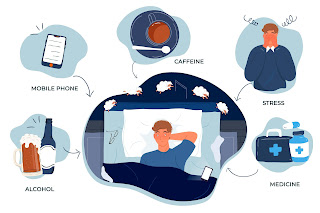5 Main Types of Sleep Disorders in Adults (With Symptoms, Causes, Treatment)
 |
Sleep is essential for overall health and well-being, yet many adults struggle with sleep disorders that disrupt their nightly rest. Understanding the different types of sleep disorders, along with their symptoms, causes, and treatment options, is crucial for improving sleep quality and addressing underlying issues. In this article, we will explore the five main types of sleep disorders in adults, providing insights into their manifestations and offering guidance on effective treatment strategies. Additionally, we will discuss the role of online mental health courses in supporting individuals affected by sleep disorders.
Insomnia:
Symptoms: Difficulty falling asleep, staying asleep, or waking up too early, leading to daytime fatigue, irritability, and difficulty concentrating.
Causes: Stress, anxiety, depression, irregular sleep schedules, caffeine or alcohol consumption, certain medications, or underlying medical conditions.
Treatment: Cognitive-behavioral therapy for insomnia (CBT-I), sleep hygiene practices, relaxation techniques, and medication therapy (when necessary) under medical supervision.
Sleep Apnea:
Symptoms: Loud snoring, gasping or choking sensations during sleep, daytime sleepiness, morning headaches, and irritability.
Causes: Obstructive sleep apnea occurs when the airway becomes blocked during sleep, while central sleep apnea results from a dysfunction in the brain's respiratory control.
Treatment: Continuous positive airway pressure (CPAP) therapy, oral appliances, lifestyle modifications (weight loss, smoking cessation), and in severe cases, surgical interventions.
Restless Legs Syndrome (RLS):
Symptoms: Unpleasant sensations in the legs, accompanied by an irresistible urge to move them, often worsening at night and during periods of inactivity.
Causes: Genetics, iron deficiency, pregnancy, peripheral neuropathy, kidney failure, or certain medications.
Treatment: Lifestyle changes (regular exercise, avoiding caffeine), iron supplementation, medications (dopamine agonists, alpha-2 delta ligands), and relaxation techniques.
Narcolepsy:
Symptoms: Excessive daytime sleepiness, sudden loss of muscle tone (cataplexy), sleep paralysis, hallucinations upon falling asleep or waking up.
Causes: Dysfunction in the brain's regulation of sleep-wake cycles, often related to a deficiency in hypocretin (orexin) production.
Treatment: Stimulant medications (modafinil, methylphenidate), sodium oxybate (to improve nighttime sleep and reduce cataplexy), antidepressants (for cataplexy), and lifestyle adjustments.
Circadian Rhythm Sleep-Wake Disorders:
Symptoms: Disruption of the natural sleep-wake cycle, leading to difficulty falling asleep or waking up at desired times, excessive sleepiness, and impaired functioning.
Causes: Irregular work schedules (shift work), jet lag, delayed sleep phase disorder (DSPD), advanced sleep phase disorder (ASPD), or irregular sleep-wake patterns.
Treatment: Light therapy, melatonin supplementation, sleep hygiene practices, gradual adjustments to sleep schedules, and behavioral interventions.
Conclusion:
Sleep disorders can significantly impact an individual's quality of life, affecting physical health, mental well-being, and overall functioning. Recognizing the symptoms, understanding the underlying causes, and seeking appropriate treatment are essential steps in managing sleep disorders effectively. Whether through medical interventions, lifestyle modifications, or behavioral therapies, addressing sleep disturbances can lead to improved sleep quality and enhanced overall health. Additionally, online mental health courses can provide valuable resources and support for individuals struggling with sleep disorders, offering guidance on stress management, relaxation techniques, and cognitive-behavioral strategies to promote better sleep habits and overall well-being. By prioritizing sleep health and seeking appropriate support and resources, individuals can take proactive steps toward achieving restful, rejuvenating sleep and enjoying a healthier, more fulfilling life.
Also Read: 10 Seated Yoga Poses for Flexibility – A Step by Step Guide
Thanks For Reading!



Comments
Post a Comment